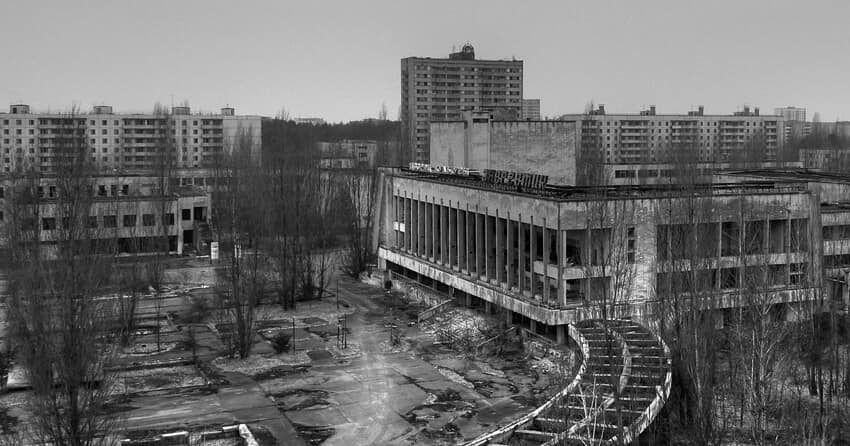Pripyat the ghost city

The city of Pripyat was just 3 km from the Chernobyl nuclear power plant where the world’s worst nuclear disaster took place in 1986, when one of its light water nuclear reactors exploded. The accident transformed Pripyat into a ghost city and even now, more than 30 years later, it still remains a ghost city.
I visited Pripyat in 1989, three years after the Chernobyl disaster. It was the ninth specially designed city for nuclear power plant workers of the Soviet Union. Pripyat was built for those who worked in the nearby Chernobyl nuclear power plant.
These were normally “closed cities” and visitors were not allowed to enter them and as far as I know no Indian journalist has ever been there. Pripiyat was a thriving city of over 50,000 inhabitants before it bame a ghost city.
It was a young city named after the nearby river of the same name. The vital statistics of this self-contained city in 1986 was impressive: The average age of residents was 26 years. There were 75 primary schools, 19 secondary schools and 7 professional schools. There was one hospital, 3 clinics, 25 stores and malls, 27 cafes, cafeterias and restaurants to serve as many as 5535 customers at a time and 10 warehouses. There were three cultural centres, a place of culture, a cinema hall and a school of arts with 8 different societies to meet the citizens’ cultural and entertainment needs. For sports, there were 10 gyms, 3 indoor swimming pools, and 35 playgrounds including one with a huge Ferris wheel. It had railway connection with a large station, 167 urban buses, and four factories besides the nuclear power plant.
Chernobyl is barely a two-hour trip by car from Ukraine’s capital Kiev. Though three years has passed when I visited the place, the trees and shrubs en route bore the signs of the disaster, denuded and discoloured as they were.
The trees surrounding the plant were killed by high levels of radiation. This region came to be known as the "Red Forest" because of the dead trees that later turned a bright ginger red colour, according to Marc Lallanilla who visited the area as soon as it was opened to scientists (Live Science September 25, 2013).
Some 4000 people, mostly the workers who tried to put a sarcophagus over the reactor in a bid to contain the spread of its radioactivity, are estimated to have died from the ill effects of radiation. First it was thought to be an electrical fire but when the graphite core debris began flying all around after the explosion, the gravity of the accident was realised. But it was too late by then.
The Pripyat residents began to be evacuated only after almost 36 hours has passed. The same was the case with the old Chernobyl town, situated some 15 km away from the Chernobyl power station.
When this writer visited the Chernobyl power plant in 1989, together with an American scientist and two other journalists, the implicit fear of radioactivity was persisting. After several checks of our identity and explanation by our official guide about the purpose of our visit, we were allowed to enter the Chernobyl exclusion zone, 30 km from the plant.
To enter the power plant area, we had to wear special protective clothing and go through several checks through various radiation control entry points. I entered the plant with trepidation without knowing whether radiation was going to affect me despite all the checks and precautions.
What we saw in Chernobyl was something unbelievable. The reactor had been entombed under a huge cement and iron sarcophagus. It was covered again in 2006 to avoid any further radiation leakage. The cause and effects of the horrible disaster has been widely reported and analysed and are now well known. So there is no point in repeating them here. Before coming out from the power plant, we were taken to another reactor and explained the additional safety measures that have been put there since the accident. We underwent another check and were then allowed to shed the protective clothing after coming out of the plant.
The most atrocious fact of the Chernobyl nuclear disaster was that the then Soviet government tried to hide the fact of the disaster. It is only when radioactive clouds crossed Belarus and moved into Western Europe, especially Scandinavia, was the accident admitted.
Our visit to the Pripyat city was really heart-rending. It bore all the marks of a ghost city and reminded one of the scenes from the American film “On the Beach” where no one survived after a nuclear holocaust. We had to don another set of protective clothing to enter the city. There were no birds flying overhead. Total silence prevailed. Not a single living being other than us was out on the streets. Open windows were slowly flapping in the light wind, remnants of bed sheets kept out for drying three years ago were still billowing in the light breeze and at one place, a tattered carpet was hanging. No one touched them for fear of radioactive contamination. We were also told not to touch or pick up anything.
Entering one of the flats, I saw a child’s bicycle lying at the entry point and several toys strewn around. Plates were heaped in the kitchen sink. It was really eerie. The city bore all the signs of a hurried evacuation. The population was asked to carry only the essentials with them and were told that they would return in a few days. No one has returned since and Pripyat remains a ghost city though some people have come back to the old Chernobyl town.
Chernobyl is a symbol of man’s carelessness. The area is still not free from radiation danger, according to many scientists. There is fear that no human settlement in the exclusion zone can be totally safe for another 20,000 years.
